Rennie Scaysbrook | July 26, 2019
Pikes Peak 2019: The Race to the Clouds
The 97th running of Pikes Peak International Hill Climb was one of the most dramatic in its history. Records were broken, but more importantly, a great man was lost.
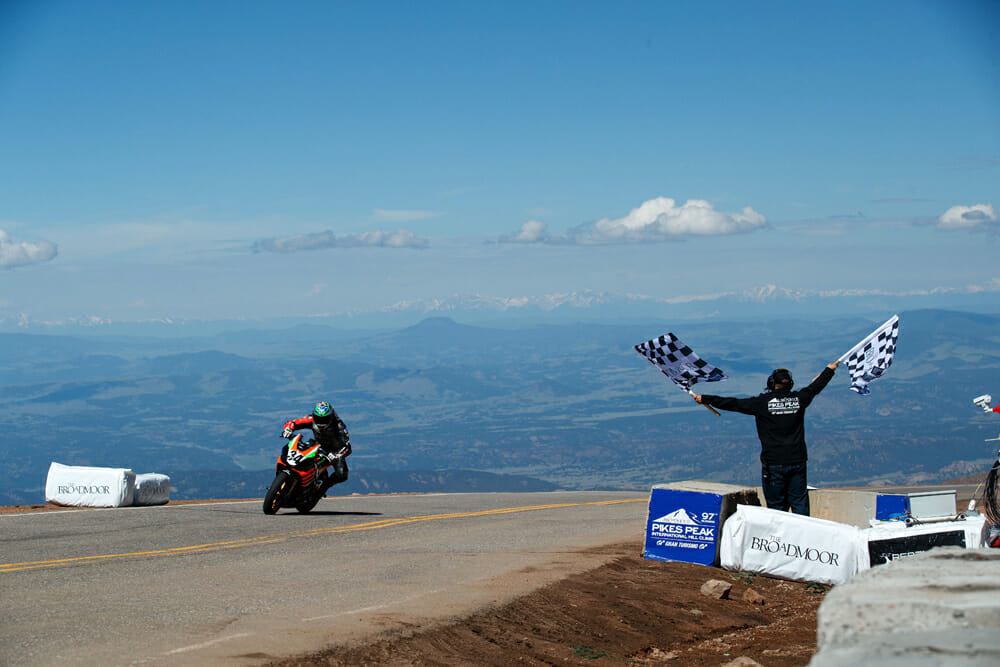 The highest finishing line in motorcycle racing sees Rennie cross it as a winner for the first time, right before tragedy struck.
The highest finishing line in motorcycle racing sees Rennie cross it as a winner for the first time, right before tragedy struck.
Sitting in the hire truck, watching re-runs of my ride from the 2017 Pikes Peak International Hill Climb, it strikes me that I feel dramatically calmer than in any of my previous attempts in The Race To The Clouds.
No one is looking at me. I’m locked away in the air-conditioned comfort of a Ram 4×4, taking final mental notes of the course, waiting for my time to saddle up.
Finally, I get a little antsy.
Even though it’s about 15 minutes before my start, I decide the brain has had enough study and I take my walk to the Ducati Hot Grid, greet my Aprilia USA team members, and take a seat behind my Aprilia Tuono Factory 1100.
My close mate, Chris Fillmore, calls my name from two bikes down the grid. We lock eyes, give each other a thumbs up, and simultaneously say, “see you at the top.”
The silence is split as Germany’s Lucy Glockner fires her BMW HP Race. The waiting crowd and the assembled team members from BMW, KTM, Ducati, and Aprilia give her a huge cheer, and the fastest woman in the history of Pikes Peak rolls down the corridor to flag starter, Frank.
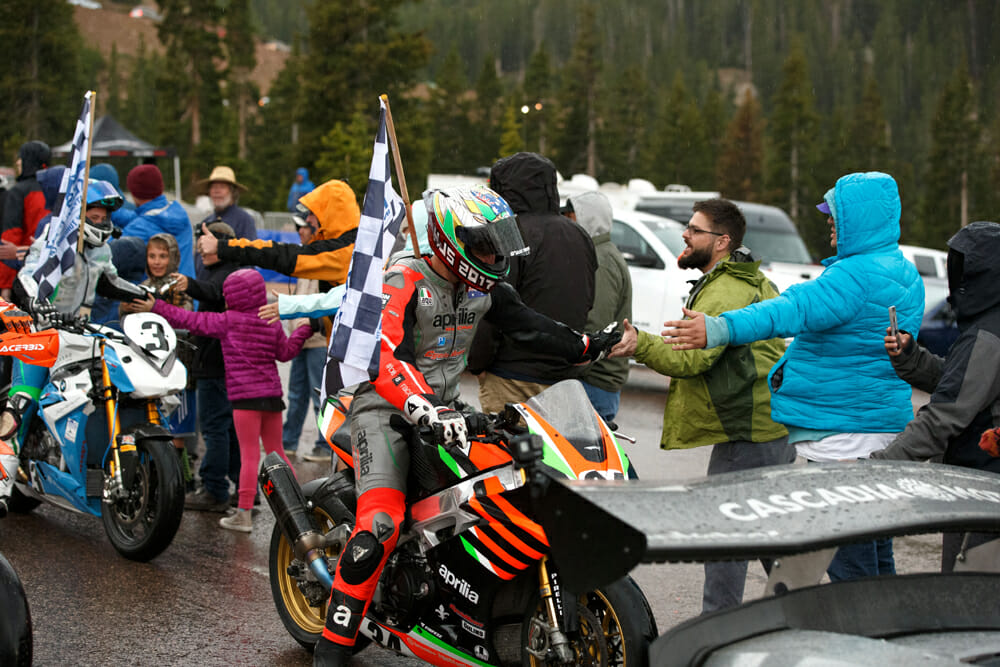 Rennie and second placed Lucy Glockner share the spoils of the crowd, who braved rain, hail and even snow to be there on race day.
Rennie and second placed Lucy Glockner share the spoils of the crowd, who braved rain, hail and even snow to be there on race day.
Two and a half minutes later, Fillmore—who incredibly qualified third fastest of all—fires his KTM 450SX supermoto, gives the crowd a barking rev, clicks first gear and rolls away.
Then it’s Ducati’s Codie Vahsholtz—my main competition for the 2019 Heavyweight crown. Pitted an arm’s length away, I give Cody a fist bump just before he selects first gear on the Ducati Multistrada MTS1200 Pikes Peak, and he rides out of the pit lane awning.
Then it’s just my Heavyweight category Aprilia and I, with the Exhibition Powersport category Ducati Streetfighter V4 Prototype of Carlin Dunne on my right.
Staring at the little Aprilia badge on top of my dash, blocking out all distractions, I’m now officially in the zone.
Just before I thumb the black starter button on my right ’bar, a hand reaches and taps me on the left shoulder. It’s Carlin Dunne. We look right into each other’s eyes, wish each other the best of luck, and we’d see each other on top of America’s Mountain. I click first, rev the life out of the Aprilia to pump myself and the crowd up, take to the grid and dump the clutch for what will become the ride of my life.
Fifteen minutes later, Carlin Dunne is dead.
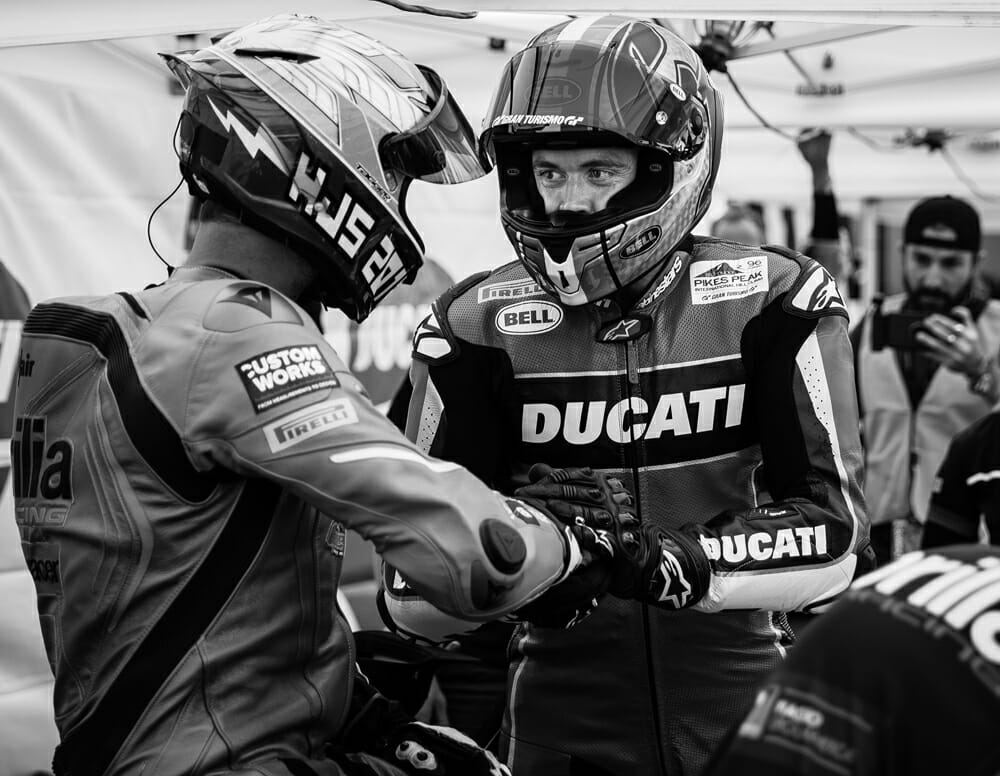 Dunne and Scaysbrook share a good luck chat seconds before Rennie takes the start. It would be the last time the two would meet.
Dunne and Scaysbrook share a good luck chat seconds before Rennie takes the start. It would be the last time the two would meet.
America’s Mountain
The Pikes Peak International Hill Climb, held on what’s long been called America’s Mountain, is the most famous event of its kind anywhere in the world. Describing the race as dangerous is a gross understatement. To take on Pikes Peak is to accept the very real possibility of serious injury or worse. Multiple winner Greg Tracy once told me racing Pikes Peak was akin to surfers who chase the world’s biggest waves, knowing full well each mistake could be their last.
Like the Isle of Man TT Mountain Course, the rush of completing a good run at Pikes Peak is one of the most potent any adrenaline junkie can find. That’s why I have come back to this most treacherous of races for the last four years, to get my fix, and to become the first Australian to take the King of The Mountain crown.
At 12.42-miles (19.98 km), the course starts at an elevation of 2743 meters (9000 feet) before reaching a climax of 4300 meters (14,100 feet), nearly half the height of a cruising passenger airliner. Pikes Peak mountain itself towers over the Colorado Springs landscape like a matriarch, its snow-covered tips always in view from any area of the city.
The mountain is a source of great pride for the locals—a symbol of mother nature’s beauty and her fury—and one that provides the most unique racing venue anywhere in the world.
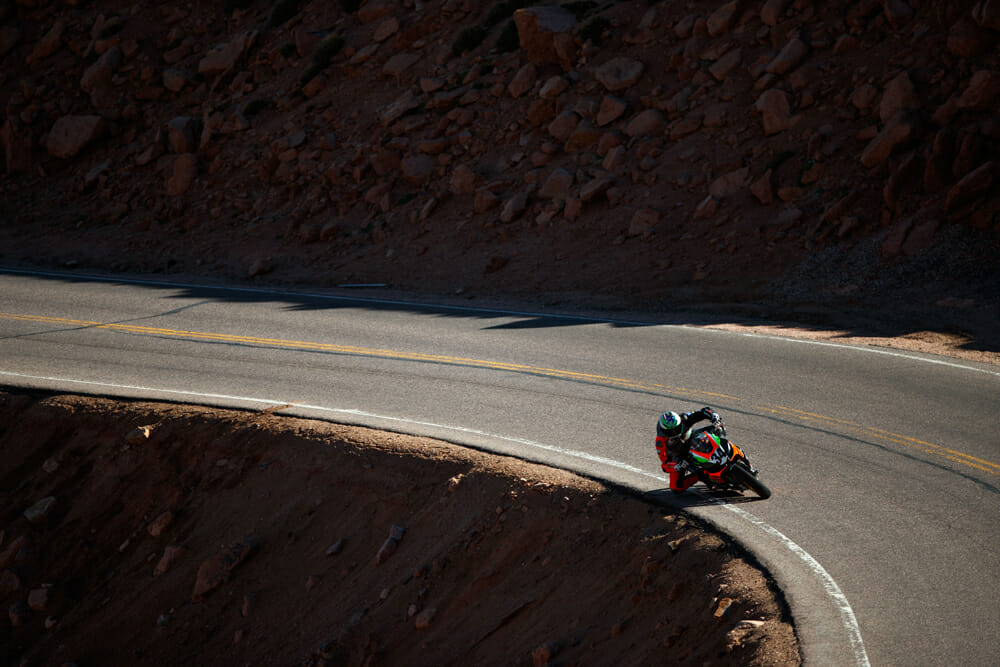 The W’s provide the steepest elevation increase as Rennie banks into the penultimate corner of the section during practice.
The W’s provide the steepest elevation increase as Rennie banks into the penultimate corner of the section during practice.
The race itself dates back to 1916 and is the second oldest motorsport event in the U.S. behind the Indianapolis 500, with its history littered with the names of great drivers like Unser, Loeb, Vatanen, and Dumas, and riders like Fillmore, and Dunne.
Motorcycles and cars share the day, held this year on the 30th of June, with the bikes on track first, usually between 7:30 am to 10:00 a.m. The latter time coincides with the best track conditions available—the air is hot, the track is grippy, and the road has been “cleaned” by the previous 25 or so riders who qualified behind the pole sitter. It’s the perfect time to lay it on the line.
From the start, the course takes on more of a traditional road race circuit style—if any comparisons can drawn. This sinuous stretch of tarmac has traditionally been my best section, as the braking is not as abrupt and you can let the motorcycle flow from corner to corner, keeping the roll speed up and getting as much heat into the tires as possible.
From there it’s into section two—called The W’s—named so as it is 10 hairpins connected by various straights and decreasing radius corners with the climb in elevation at its steepest.
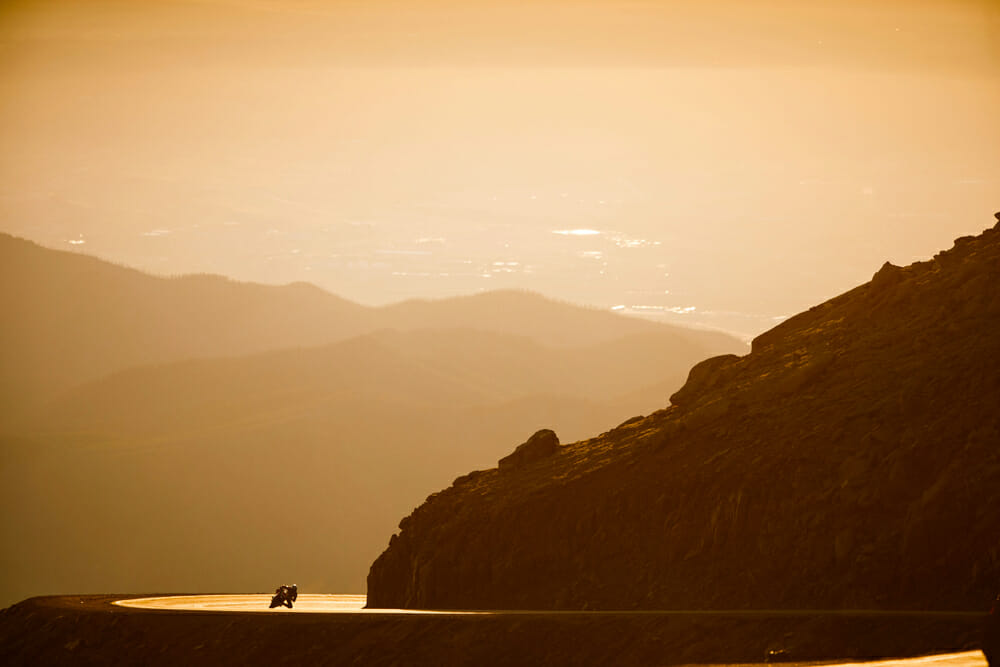 6:00 am on Day Two in The W’s. You’d have to be a pretty average photographer to take a bad shot with this light.
6:00 am on Day Two in The W’s. You’d have to be a pretty average photographer to take a bad shot with this light.
For some, this is the easy part. For me, it’s the most difficult, as I have always been a bit of a wimp on the brakes because you’re rushing up to an Armco barrier time after time, a bit like at the Macau Grand Prix.
Section two ends at an area called Devil’s Playground, signalling the riders and drivers they are about to enter the fastest part of the course. The highest top speed is actually reached in the first section at an area called the Picnic Grounds, but it’s only for a short period. Devil’s Playground to The Summit is fourth, fifth and sixth gear for around 80 percent of the time, which, combined with the rapidly rising altitude, makes for an incredibly stressful situation.
When you reach The Summit, you know you’ve done something special.
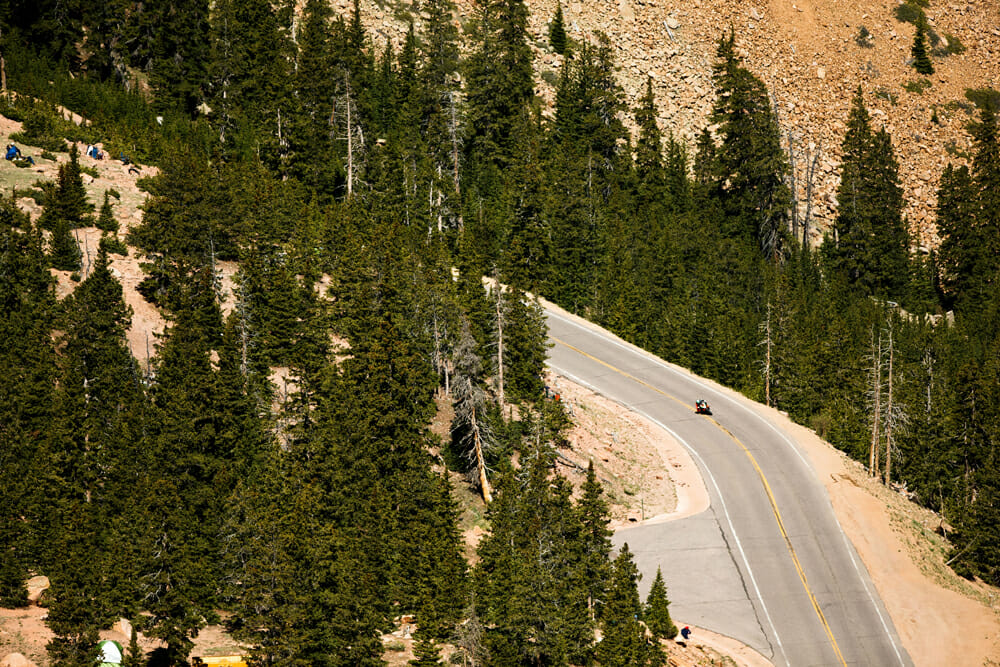 Rennie during the race on the run up to Elk Park, the scene of his lucky escape in 2016.
Rennie during the race on the run up to Elk Park, the scene of his lucky escape in 2016.
Switching Sides
The previous three years saw me competing at Pikes Peak for the factory KTM North America outfit, where I took fourth overall in 2016, and second in 2017 and 2018—the last of which by 0.692 seconds to Dunne—in what is the closest finish in the history of the race for cars or motorcycles. Crucially, I was second in the Heavyweight class every year. This was something I dearly, dearly wanted to correct.
For 2019, my personal Pikes Peak journey took a new route. I moved to Team Aprilia USA, and this year’s race was the culmination of six months of development work, taking a 2018 press demonstrator model Aprilia Tuono 1100 Factory and converting it into a mountain racer.
I also had—for the first time in my racing life—a real racing team devoted entirely to me. Consisting of seven members, I had a team manager in Shane Pacillo; mechanic Mark Cochran; a data technician from Aprilia’s HQ in Noale, Italy, in Nicola Marcato; general team helper, Jeff Pfahler; Pirelli tire technician, Oscar Solis; Piaggio USA’s marking manager, Marco D’Acunzo; and perhaps, most importantly, my Crew Chief, former Pikes Peak champion and Isle of Man TT racer, Jeremy Toye.
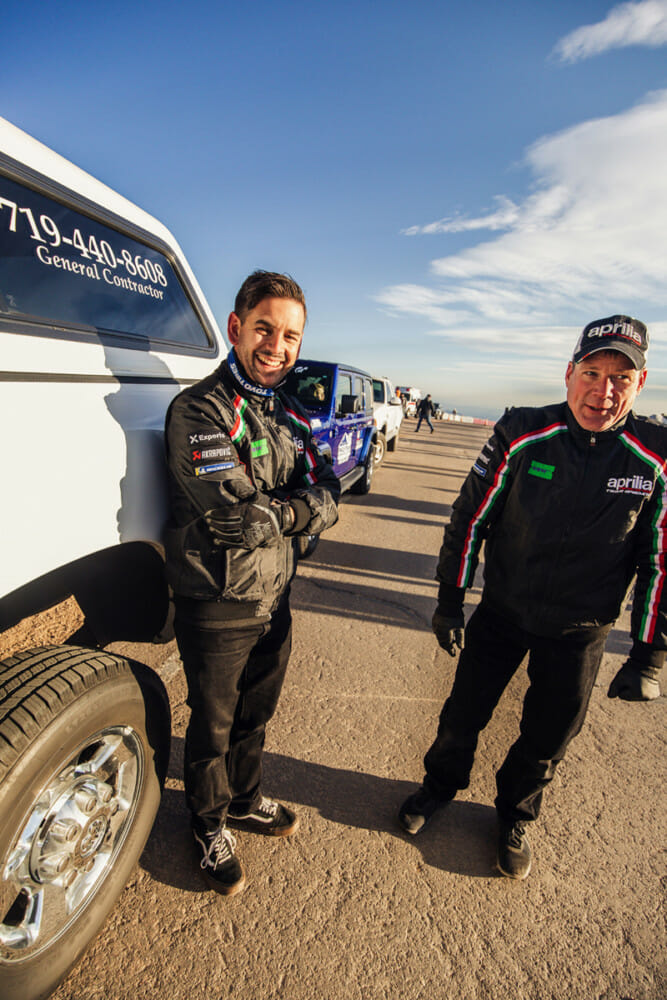 Team manager Shane Pacillo (left) and Mark Cochran try to stay warm on top of the mountain. Easier said than done.
Team manager Shane Pacillo (left) and Mark Cochran try to stay warm on top of the mountain. Easier said than done.
Having this team alleviated an enormous level of stress from me—I could just focus on riding as best I could and trying to give clear, concise feedback on the Aprilia’s performance so Jeremy could make his educated call on set-up.
The role of Jeremy Toye cannot be underestimated. When Aprilia asked if I’d head up this project, my only stipulation was that I needed a real team under me that Jeremy was the leader of. Toye’s technical knowledge was one thing, but his true value came through in the calming, timely nature of the advice he gave me from the first test to race morning.
Jeremy could see when I was anxious and would say the correct things without any prompting, at the correct time, and could give me insights into my riding I simply didn’t see. There is absolutely no doubt in my mind had Jeremy Toye not been with me, this project would have failed.
 Rennie discussing strategy with Crew Chief, Jeremy Toye. “Without Toye, this project would have failed,” Scaysbrook admits.
Rennie discussing strategy with Crew Chief, Jeremy Toye. “Without Toye, this project would have failed,” Scaysbrook admits.
VIDEO | Cliff Racer III: Racing To Win At Pikes Peak 2019
Action Stations
Race week starts with tech and sign-on day on the Monday, then official qualifying for the motorcycle contingent is held on the Tuesday on the bottom section. However, after qualifying second to Carlin Dunne overall and first in class, the team and I are far from happy with the Aprilia’s performance.
We are struggling with the power delivery. It’s coming too late in the throttle application—the available maps in the standard ECU simply don’t allow for a clear 1-1/throttle-to-rear wheel ratio—and I’m losing valuable seconds despite riding as hard as I know. It’s a case of “computer says no.”
By the end of the day, I’m five seconds off what I did on the KTM 1290 Super Duke R in 2018 on a shagged rear tire, and very pissed off.
That’s when we make the SOS call to Noale, and within 12 hours, Nicola is on a plane heading to Colorado with a new Marelli ECU mapped my Aprilia Racing. He will arrive on Thursday, but before then, we finish up second in class to Vahsholtz and fourth overall in The W’s on Wednesday. Things are not looking good.
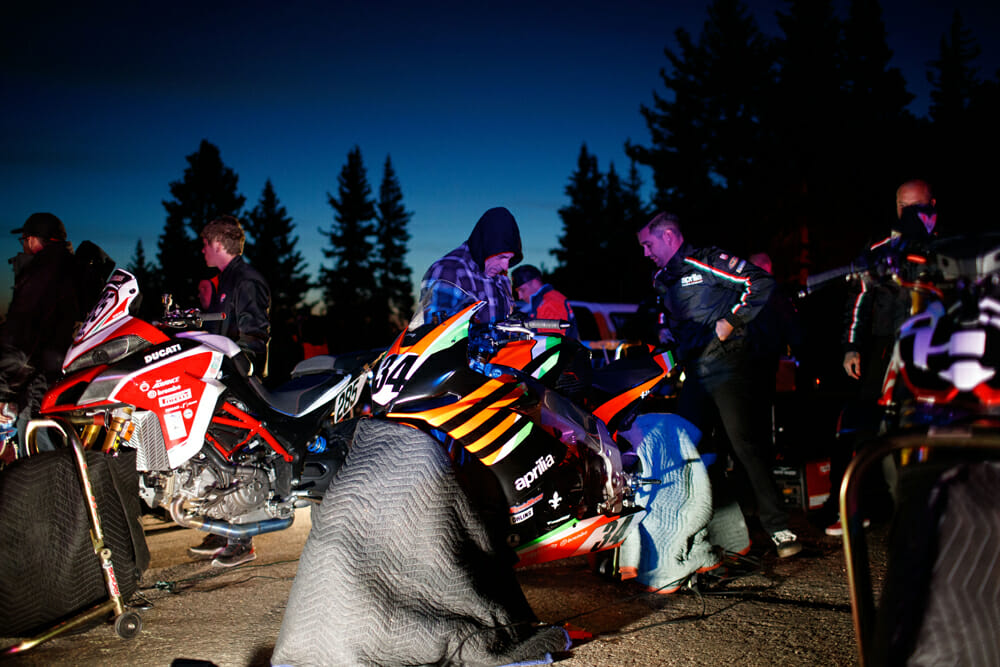 Day Two, 5:45 am. Rennie’s Aprilia is sandwiched by the two factory Ducati’s of Dunne (right) and Vahsholtz. At this stage, the Ducati’s had the upper hand.
Day Two, 5:45 am. Rennie’s Aprilia is sandwiched by the two factory Ducati’s of Dunne (right) and Vahsholtz. At this stage, the Ducati’s had the upper hand.
Carlin Dunne is simply on another level. I must remind myself he is in a different class with about 40 horsepoer more on tap (his machine is a Ducati Panigale V4 S with the fairings taken off and a one-piece handlebar attached), but we all still count to the overall result. He is riding the Streetfighter Prototype like a god, arcing his way up the mountain a second ahead of his own movements.
Lucy Glockner is also incredibly impressive as she goes second overall on day two, backing the exotic BMW in like she’s in her usual realm of the Endurance World Championship.
Day three from Devil’s Playground to The Summit rolls around and Nicola brings the magic ECU and map. I liken the situation to the team and I’m standing at the castle gates, pounding to get in, while Nicola just turns up with the key and walks through.
Suddenly, the hills are alive with the sound of an Aprilia V4 at full noise, and I go second to Dunne overall but more importantly I’m three seconds up on Vahsholtz.
This increase in speed is confirmed once again by the team, and I topped the class on the final day of practice on Friday, once again held in The W’s. I’m only about 0.7-seconds up on Vahsholtz, but I’ll take it after being nearly two seconds down on Wednesday.
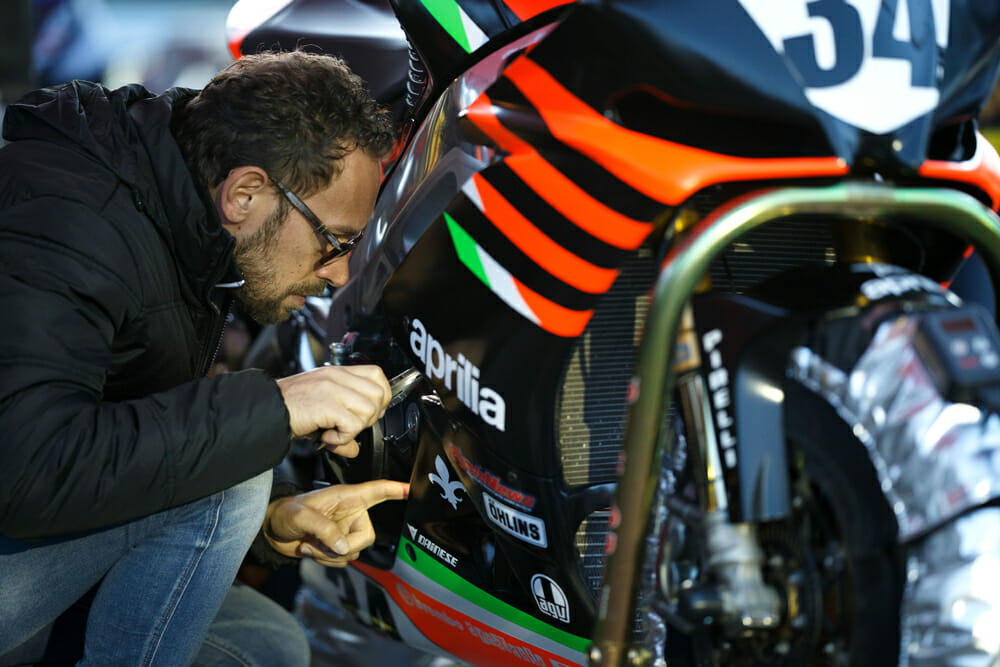 Nicola Marcato inspects the Aprilia during Day Three of practice. His expertise in mapping the Aprilia made all the difference in overall performance.
Nicola Marcato inspects the Aprilia during Day Three of practice. His expertise in mapping the Aprilia made all the difference in overall performance.
Game On
All this leads to a great feeling on race morning, Sunday, June 30. Having chosen to go for the Pirelli Diablo Superbike SC0 (super soft) tires front and rear, and with all eyes on Carlin and not me, the team and I are in a great place.
The bike is perfect. The chassis is dialed, the ECU’s engine braking and throttle strategies are sorted—it’s game on.
After Carlin wishes me good luck, Jeremy looks me in the eye and says, “Remember: straight line braking; maintenance throttle; stand the bike up early. Ride like you know how to ride.”
Revs up, flag man Frank waves me off, and I carefully release the clutch.
The next 9 minutes and 44.963 seconds are the best I’ve ever ridden a motorcycle in my life.
Being cognizant of Jeremy’s riding advice I’ve soaked up over the week, I talk myself through the run, and by the time I reach the Bottomless Pit turn just after Devil’s Playground, I’m hitting the limiter in sixth gear whereas in practice I was barely doing that in fifth. That’s when it hits me: as long as I hold it together, this run will be a good one.
Out of the seat through Boulder Park and riding the Aprilia like an enduro bike, I remind myself to keep my shit together. I purposely keep it tight through the final two corners to give myself plenty of wiggle room, and ride over the line.
About 10 seconds later, I see Chris Fillmore running up to me, his arms raised triumphantly with an enormous smile across his face. Then it hits me: I’ve just won the Heavyweight Class.
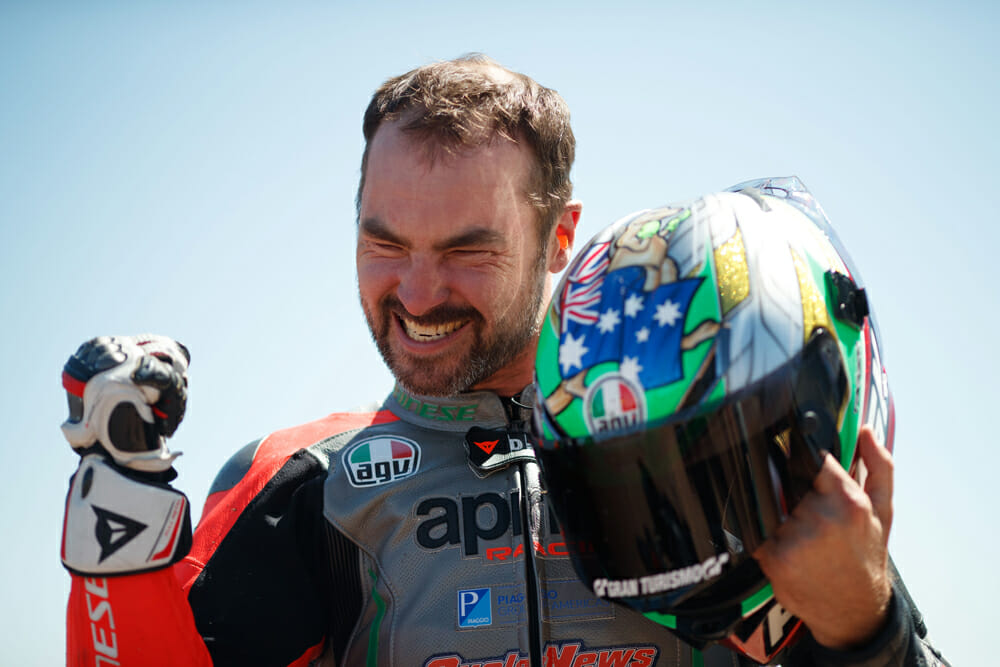 That’s four years of work realized with Australia’s first Pikes Peak Heavyweight category win.
That’s four years of work realized with Australia’s first Pikes Peak Heavyweight category win.
But, it gets better.
Chris then tells me I smashed his lap record by 4.662 seconds. It’s the best feeling of my life aside from my wedding day and when my son was born.
A television crew rushes up to me and puts a microphone under my nose. But after five minutes of chatting to them, I ask, “hang on, I’ve been talking to you for ages, where’s Carlin? He should be here.”
Convincing myself he’s probably okay, I keep chatting. Little do I know, he’s about 40 meters away on the other side of the carpark embankment, taking his final breath.
Carlin Dunne was set to annihilate my time on the Ducati Streetfighter V4 Protoytpe. He was 1.323 seconds up in the first split, 2.528 up in the second, 3.953 seconds up in the third, until he high-sided the machine barely 15 meters from the finish line. Dunne, a man with four previous race wins at America’s Mountain, fell from the Ducati and down the boulder-strewn embankment to his final resting place.
Carlin’s death cast an enormous shadow over what was an incredible event. The fastest race in history, I am now the Pikes Peak record holder and overall champion, but I know the real winner is Carlin Dunne. He was the fastest rider this year—of that, there is no doubt.
Carlin Dunne is the true King of The Mountain.
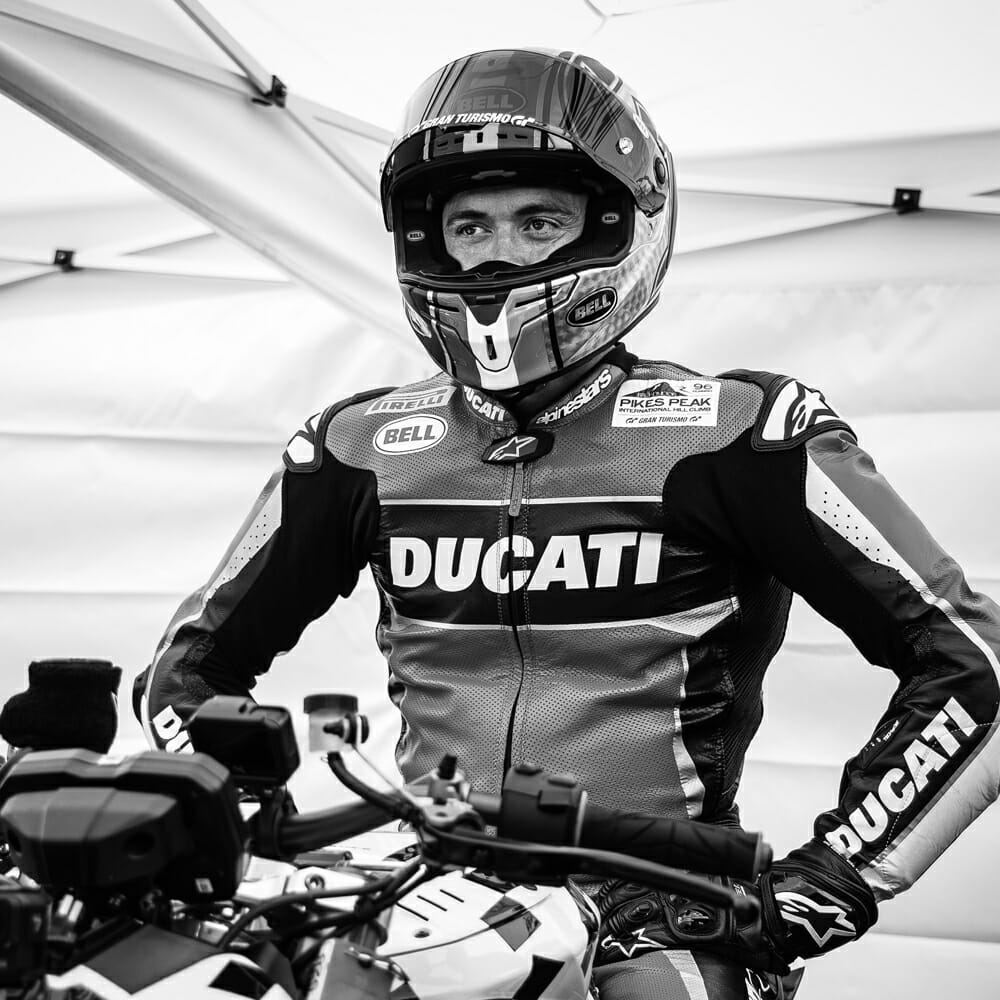
Vale Carlin Dunne
Carlin Dunne’s death at this year’s Pikes Peak International Hill Climb is on par with that of David Jefferies at the 2003 Isle of Man TT. Like Dunne, Jefferies was the man in his chosen domain, and his death carries with it an enormous level of grief from his family and friends, to the very top of Ducati management in Bologna, Italy.
Carlin and I met at the 2016 Pikes Peak event, when he was part of the Squadra Alpina program, a mentorship for rookie riders at Pikes. Gracious and calm, he was the perfect tutor to me and the other rookies that year, and I used his teachings as best I could in the following years—first to beat Chris Fillmore and second to beat him personally in 2018—both times of which I failed.
Our battle in 2018 was nothing short of epic. Dunne beat me by 0.692 seconds, the closest finish in racing history at Pikes Peak. I was distraught. I’d come so, so close. I wanted that win so bad, and to beat him in the process would have made it even sweeter.
However, Carlin was gracious in victory, and admitted to me I’d pushed him harder than anyone had ever done at America’s Mountain. That quote now has much more weight to it considering the outcome of this year’s event.
Death is a part of racing and thankfully it happens at a much rarer rate than in previous generations. Perhaps this is what makes the grief of passing so acute for so many. Carlin loved Pikes Peak, it represented his greatest personal challenge—more so than the various Baja off road races he would compete in and win—often riding solo.
Carlin was a wonderful bloke, and we are all the worse off for his passing.
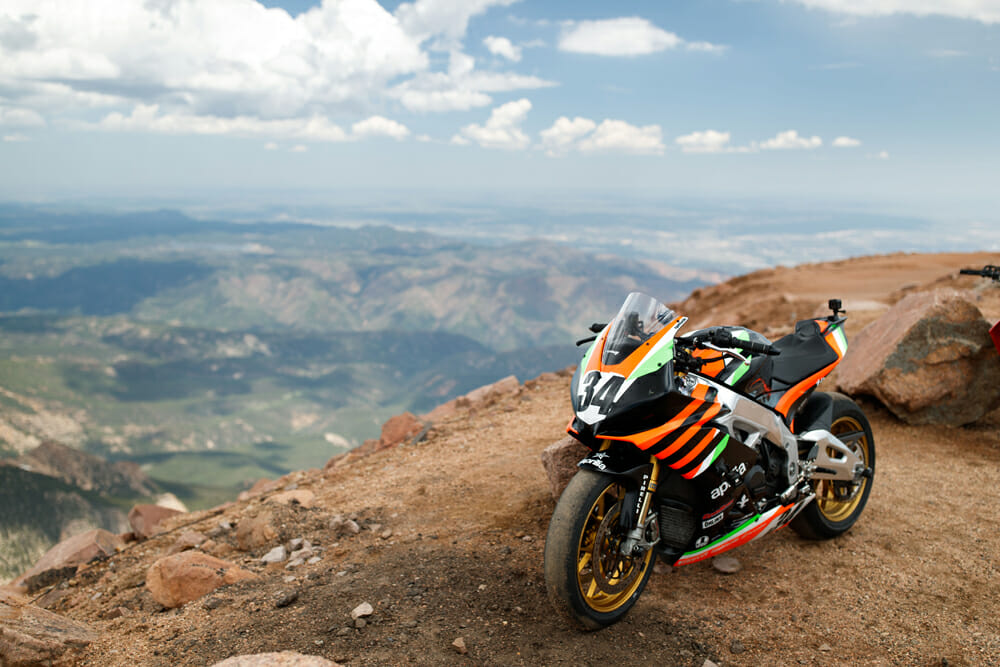
Tuning for the Mountain
As anyone who has done so will attest, taking a production bike and turning it into a racer is no easy task.
We were running in the Heavyweight division, which is labelled as for production motorcycles that come standard with a one-piece handlebar (i.e. naked bikes). As such, we chose the Aprilia Tuono 1100 Factory rather than run an Aprilia RSV4 1100 Factory in the Exhibition category, like Ducati.
The objective I wanted in the build was to have a bike with superb balance. Most of my bikes have been likely too stiff at Pikes, so this year we ran with a much softer setting. This included running a standard RSV4 1100 Factory fork with standard 1.0 springs (although revalved damping), and an Ohlins TTX36 shock with 0.95 springs. Both front and rear would likely be too soft for a ‘normal’ racetrack, but for Pikes it was the right way to go.
“I bet we had the most balanced bike up there,” says my Crew Chief, Jeremy Toye. “I would have liked to get a little more power out of the motor (we all want more power), but that takes time and money, something we didn’t have.
“My biggest fear (or low) was information and adjustability in the standard ECU, which turned into a high with Aprilia sending over Nicola, with a programmable ECU and logger.”
Nicola’s arrival on Day Three of practice week signalled a turning point in the project. I wanted the power to come in harder, more aggressively, so Nicola created a new throttle map to suit. The result was instant: the Aprilia now gave me everything I asked for, and suddenly we were right back in the fight against Vahsholtz and the Multistrada.
On day four, we also created a new engine braking map that allowed more freewheel from 12,500 rpm to 9000 rpm, then ramping up from 9000 rpm to 4000 rpm to help pull me into the apex faster. This was the biggest change to get used to, as it was a dramatic increase in overall engine braking.
Gearing was one of the big issues we faced this year. We ended up running with 15/54, more like what Aaron Colton would run during a stunt show than what you’d race with up a mountain. The shorter gearing made the first three gear flash by in an instant, so I spent most of my time in fourth, fifth, and sixth gears—except for when negotiating the hairpins, which was always in first gear.
My Great Escape
There are no small crashes at Pikes Peak, and Carlin’s death this year made me realize just how lucky I was back in 2016 on my KTM.
My crash that year was a classic case of me losing my cool. I had qualified on pole, mum and dad and my wife were there, and I was in contention to be the first Aussie to win—in my rookie year, no less.
There are no pit boards at Pikes Peak, I came out of the first third of the track convinced I was behind after missing at least 50 percent of the apexes. In actual fact, I was five seconds in front. I told myself I had to take the run to Elk Park flat—something I’d never done in practice. I clicked up to fifth, wound the throttle back and held on. I got through the blind, cliff-side corner, but when I approached the braking zone I was going about 60 km/h faster than I ever had in practice.
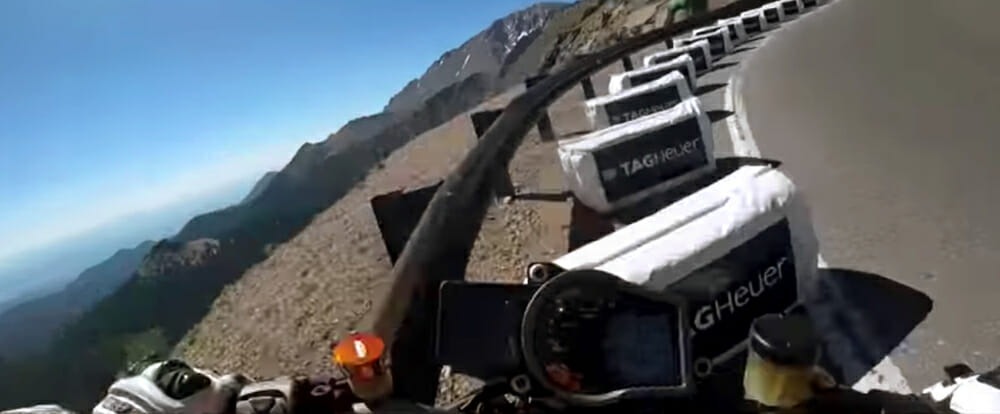
At that point, I was fu**ed.
I had three options: lowside the bike and slide into the Armco, hoping I would not break apart like Connor Toner had done at the same corner just 10 minutes before; hit the Armco head on (that was the least favorable outcome); or try and rebound off the Armco and keep riding. I chose the third option, and nearly made it (aside from the whole velocity thing). I landed on the edge of the cliff, but remarkably, the bike stayed upright between the haybales and the Armco. I got back on and finished fourth, screaming in my helmet at my failure.
But I knew I got away with something very, very few ever do at Pikes Peak. Crashing. It hurt then and still does now, but considering what could have happened, I hit the absolute jackpot for Pikes Peak crashes.CN
Pikes Peak 2019: Project Thunder—The Race Run
Here is our edited run thanks to Spenser Robert of the 2019 Pikes Peak International Hill Climb. The team and I managed to get the Team Aprilia USA Tuono 1100 Factory to the top of America’s Mountain in 9 minutes, 44.963 seconds, the fastest motorcycle time in the history of the event.
Indeed, this is a record that would have stood for all of two minutes had Carlin Dunne completed his lap, as he was well on course to crush my lap time at Pikes Peak.
We would like to dedicate this video to the late Carlin Dunne’s memory and thank all the sponsors who were a part of this project.
VIDEO | Rennie Scaysbrook Pikes Peak Motorcycle Lap Record
*If you would like to see all the videos we have created on the 2019 Pikes Peak International Hill Climb, including the build, testing, race week vlogs, the full run and documentary, head to www.youtube.com/cyclenews and go to the 2019 Pikes Peak International Hill Climb playlist.
Pikes Peak 2019: Project Thunder— Race Day
There’s very little anyone can say about the outcome of the 2019 Pikes Peak International Hill Climb. The death of four-time race winner Carlin Dunne cast an enormous shadow over what was an incredible day of racing, the team and I setting a new lap record of 9:44.963, and taking the Heavyweight Class win as well as the King of The Mountain title.
None of that matters now. Racing has lost a great ambassador, a fierce competitor, and a true sportsman, but more important than that, society as a whole has lost a great human being.
Rest In Peace, Carlin Dunne.
Pikes Peak 2019: Project Thunder—Day Four
The last day of practice for the 2019 Pikes Peak International Hill Climb saw Rennie and the team test a bunch of new parts on the Team Aprilia USA Tuono 1100 Factory.
It turned out to be a good day with the fastest time in the Heavyweight Class. Now it’s time for racing on Sunday!
Pikes Peak 2019: Project Thunder—Day Three
Today saw the men and women of the 2019 Pikes Peak International Hill Climb hit the top section of Devil’s Playground to The Summit.
It turned out to be a good day for us with the Aprilia Tuono 1100 Factory, with the fastest time in the Heavyweight Class behind overall leader Carlin Dunne on the Exhibition Class Ducati Streetfighter Prototype.
Check out the video below to hear Rennie’s thoughts and see some of the action from Day Three.
Pikes Peak 2019: Project Thunder—Day Two
The second day of the 2019 Pikes Peak International Hill Climb saw Rennie and Team Aprilia USA hit the W’s section of the mountain.
It was a solid day, with the team ending up third overall behind leader Carlin Dunne and his teammate Codie Vahsholtz. Hear his thoughts in the video below.
Pikes Peak 2019: Project Thunder—Qualifying Day
It was a massive day on the mountain for the official timed qualifying for the 2019 Pikes Peak International Hill Climb.
For us and Team Aprilia USA, it turned out to be a pretty good day with first place in the Heavyweight Class behind overall fastest qualifier, Carlin Dunne (Ducati).
Check out the diary video below to hear Rennie’s thoughts on the day.
Pikes Peak 2019: Project Thunder—Official Tire Test
With the van packed, Shane and I met at Aprilia HQ in Costa Mesa at 3:45 am on Wednesday, June 12, two days before the tire test.
On the road by 4:00 am, we drove for 18 hours to cross Nevada, Utah and into Colorado, finally catching a few z’s just outside of Denver. It was an absolutely mammoth mission, but knocking the drive out in one day meant a full day in the shop at Imperial Sportbikes as we still had to fit the bodywork, change brake pads, lock wire everything, and do a service on the race bike.
Oh yeah, the bodywork.
So… after my rant regarding that unnamed wrapping company in Fountain Valley, it’s nice to know some people do great work fast, and when agreed to.
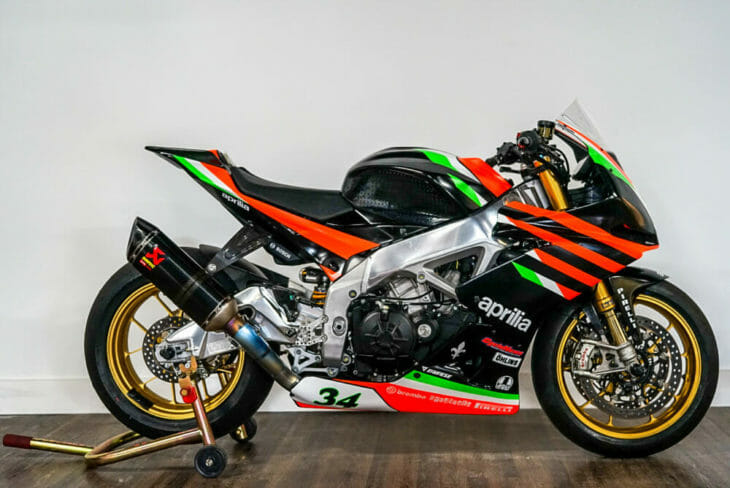 Looking like a snack! Jason Madama at Syndicate Racing and Imperial Sportbikes in Dever, CO, did a great job of saving us from having to run that awful matte black we had at Fontana.
Looking like a snack! Jason Madama at Syndicate Racing and Imperial Sportbikes in Dever, CO, did a great job of saving us from having to run that awful matte black we had at Fontana.
Syndicate Racing’s Jason Madama—the same Jason who races in the MotoAmerica Twins Cup— took hold of the job and wrapped the bike how we expected it to look the first time. Using the MotoGP Aprilia RS-GP machine of Aleix Espargaro as a base, he and Imperial Sportbikes completed the job in a little over three days, and when Shane and I turned up to Imperil to collect it, they had the bodywork dressed on an RSV4 in the showroom. Both Jason and Imperial did an absolutely stellar job and I couldn’t recommend them highly enough.
Once we’d swapped the bodywork over and done all the service work, we packed up and drove to Colorado Springs. It’s always a funny feeling coming to CS as you see the Pikes Peak mountain looming over the city in the distance like a matriarch. Her presence signals the start of the race festivities once again.
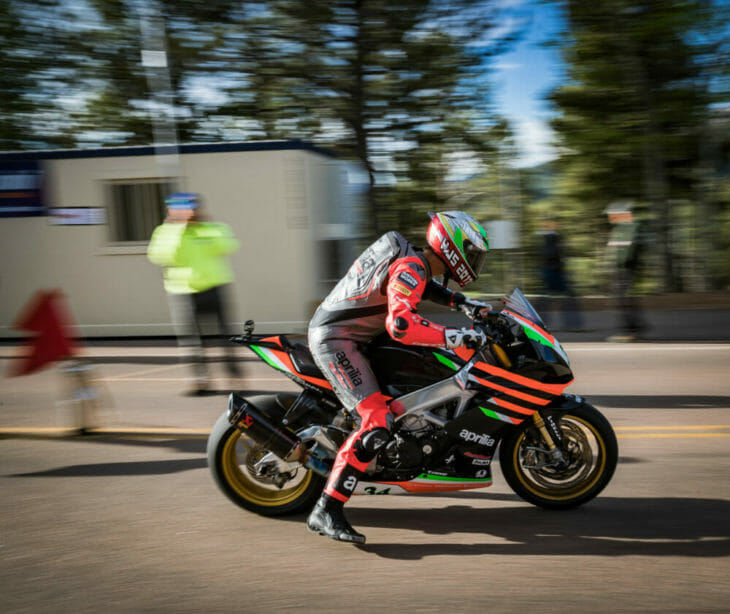 The weather was nice but track conditions were extremely slippery at Pikes.
The weather was nice but track conditions were extremely slippery at Pikes.
This year, the tire test was condensed into one day—rather than the two days we’re are normally afforded. That meant testing this year was more crucial than ever, and we quickly found out our gearing was far from ideal at the mountain course. We’ll need to shorten everything pretty dramatically for the race, but that’s the point of testing—it’s better to find these issues out now than during the race week.
The track was incredibly dirty, especially in the mid-top section from Glen Cove to the finish. In all, we got a total of four runs, three on the bottom section and only one across the top—the longest section of the course. It was a shame to have only four runs but it’s the same for everybody who has a shot of winning, so you just need to take the good with the bad.
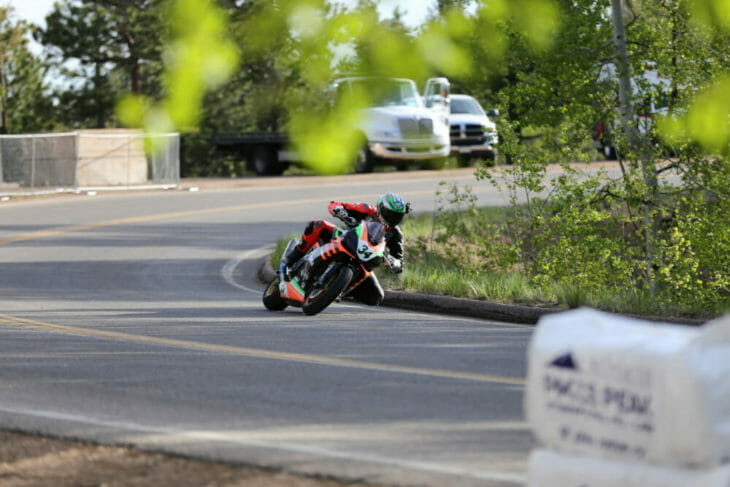 We’ve got some work to do on the bike between now and race day, but we’ll be there.
We’ve got some work to do on the bike between now and race day, but we’ll be there.
There’s really not much “tire” testing that goes on at the tire test. Really, the track is too cold, too dirty, to get any meaningful data about what you’re going to race on up the hill. We had precious little grip anyway, so we didn’t use new tires. We weren’t going fast enough to make them work, anyway.
Regardless, we now know what we have to do with the bike to make it work at the mountain. We’re back in SoCal now and will be flying out next Sunday for the race week. Let’s do this.
Pikes Peak 2019: Project Thunder—Fontana Test
The final hit-out prior to Pikes Peak 2019 occurred at Fontana last week, but the two weeks prior to the test were the most stress-filled of the entire project.
I think I’m pretty trusting by nature, and when someone says they will do a job I expect they will do it. However, this turned out not to be the case for us when we used an unnamed wrapping company in Fountain Valley in Orange County to make our bike look all pretty.
The proprietor of this business took delivery of our bike two weeks before the Fontana test, with the objective being a finished bike for the sponsor posters to be shot at Fontana. He didn’t start the design until the day before pick-up and subsequently did not get the wrap completed in time—despite having had the bike for longer than anyone who was involved in the build.
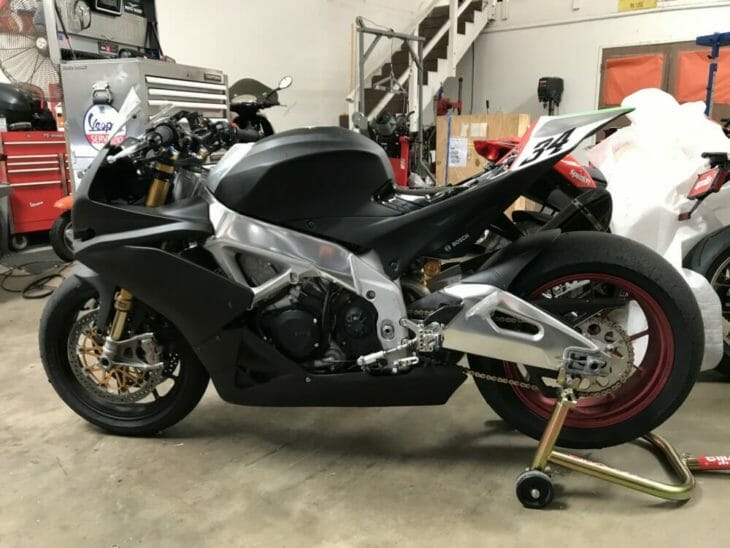 A race ready bike… this is not.
A race ready bike… this is not.
Team manager Shane Pacillo sat with him until 10:00 pm the night before the first day of the Fontana test as he finished a truly half-assed matte black design. Disgusted, this is something we’ll have to right by the tire test. The bodywork is now in transit to Denver, where Imperial Sportbikes will take over the design, paint, and wrap. Hopefully, it comes out looking nice.
Anyway, rant over. Back to the bike.
Fontana is about as far removed from Pikes Peak in terms of layout and especially the bumps, but any track time is good track time at this stage.
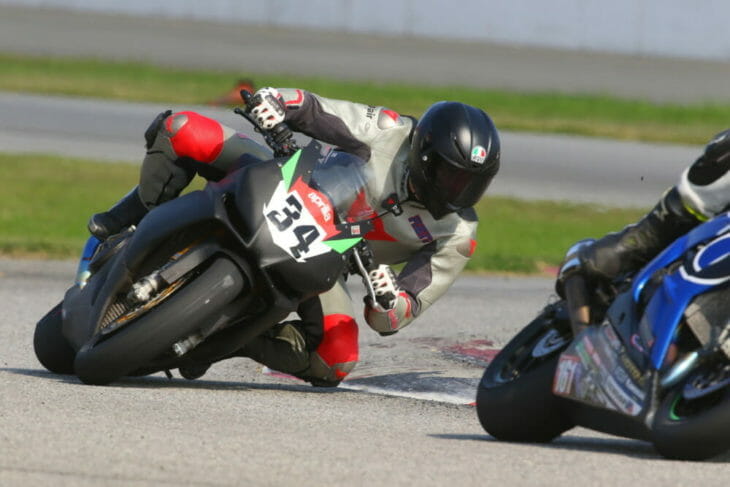 It felt damn good to get out and finally have a race to blow the cobwebs off.
It felt damn good to get out and finally have a race to blow the cobwebs off.
Three days at the Super Speedway had us working through a couple of different ECU’s—one stock and the other flashed—and we decided to go with the flashed unit as it gives a little better throttle connection at low speed compared to the standard unit.
Once we got that part of the equation figured out, we simply used the remaining time to get ready for the races on the Sunday for WERA round. It’d been nearly two years since I’d competed in a Superbike mass-start race, and with us having to start from the back of the grid as we had no points in the series, turn one was a little hectic.
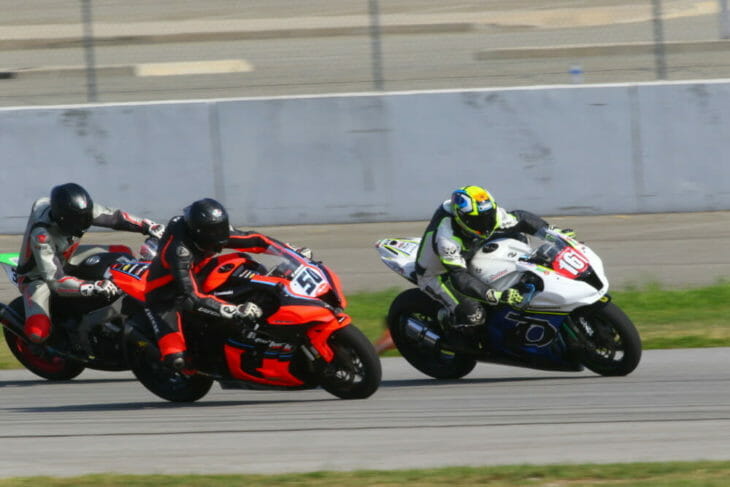 The last lap of the final Expert Superbike race at Fontana. Maybe a little more horsepower would have gotten us the win, who knows. But it was awesome fun trying!
The last lap of the final Expert Superbike race at Fontana. Maybe a little more horsepower would have gotten us the win, who knows. But it was awesome fun trying!
The good news was, even though we were down a lot of horsepower compared to the full-house superbikes that were on the grid, we still managed to get to the front. I ended up with a best time of 1:30.8, which was nearly four seconds up on my best time so far at Fontana, with a fifth, fourth and third place finish to show for it.
Now it’s time to pack everything up and head to Pikes Peak for the tire test. This year we’ve only got one day’s testing on the schedule, rather than the traditional two, so it’s a super-important time for us.
Time to get this on!
Pikes Peak 2019: Project Thunder—The Ridge and Buttonwillow
It’s been full steam ahead for Project Thunder ahead of Pikes Peak 2019. In the past week, we’ve been on the bike twice, first up at incredible facility of The Ridge Motorsports Park in Washington (if you haven’t ridden this track, you really should) and this week at our old stomping ground of Buttonwillow in California.
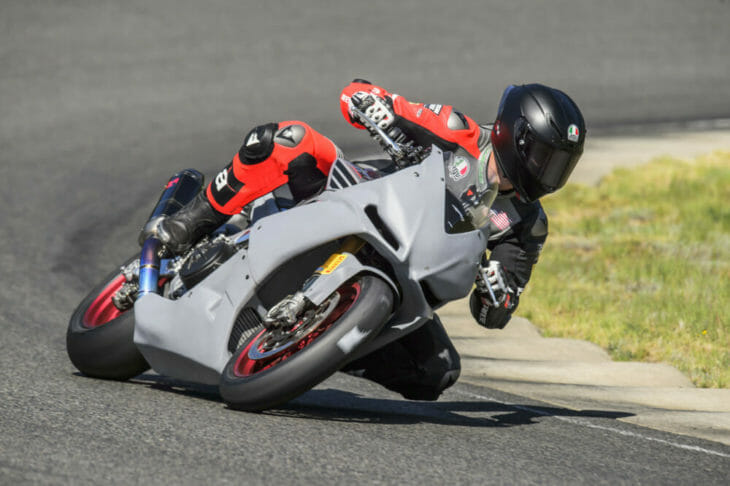 The Ridge has some incredible twists and turns and is a real gem for testing bikes. So far, the Aprilia is heading in the right direction but the tire test will be crucial.
The Ridge has some incredible twists and turns and is a real gem for testing bikes. So far, the Aprilia is heading in the right direction but the tire test will be crucial.
Our time at The Ridge coincided with the first opportunity to try out the Brembo thumb brake, which is something I’ve been busting to use for years. Not being a massive rear brake user, it wouldn’t be a huge loss if I didn’t like the system, but after three laps I was absolutely thrilled with how the brake performs.
The thumb system doesn’t have the same level of feel you get with a foot brake, but being able to use the rear brake while cranked over in right-handers is a bonus. We have essentially bypassed the ABS system with this unit, running a line straight from the master-cylinder to the caliper. If we go deleting the ABS system entirely, we’ll likely throw up a huge array of fault codes in the ECU that we really don’t have the time to sort out. Plus, the ABS system on the Aprilia is extremely light, so we’ve decided just to leave it there and save the angst.
The twists and turns of The Ridge are a lot like the first three miles of the Pikes Peak mountain, and with a decent set-up there, we packed up and drove south to Buttonwillow for another day on Monday.
Pikes Peak 2019: Project Thunder—Off to Buttonwillow
Buttonwillow has some gnarly switchback slow corners like turn three, fast sweepers like the Riverside corner, and almost everything in between. However, unlike Pikes Peak it is quite flat, but if you nail down a decent set up there you’re in pretty good shape for the mountain in Colorado.
This test proved to be the most important of the three we’ve done so far, as it was the first time Jeremy Toye would get on the bike to give me his feedback of a bike he helped build.
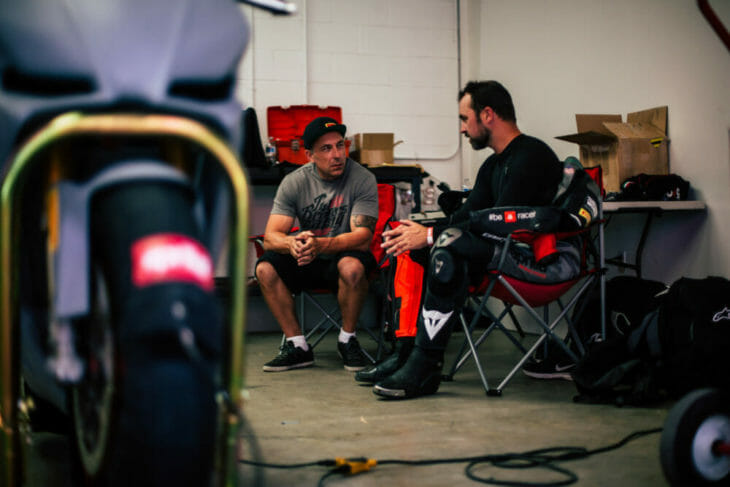 Having Toye in our stable has been a massive help in getting the Aprilia handling correctly.
Having Toye in our stable has been a massive help in getting the Aprilia handling correctly.
I’ll be the first to admit that I’m not a whiz at setting up a bike—I can get it close, but someone of Jeremy’s level can get the bike that much better and within five laps, we’d started ripping into the fork setting, playing with different preloads and compression settings to try and get the bike handling better at the top of the stroke—like in quick direction changes when the fork is almost fully extended.
Stability on the side of the tire was always a strong point of the Tuono, so we went back and forth over the day to keep this benefit while allowing the chassis to pivot and fire out of slow speed corners—something that will be extremely important in the W’s section of the mountain.
Later in the day, we went up one spring rate to a 0.95 spring, which was something I initially thought would be a step too far as I was quite happy with the 0.90.
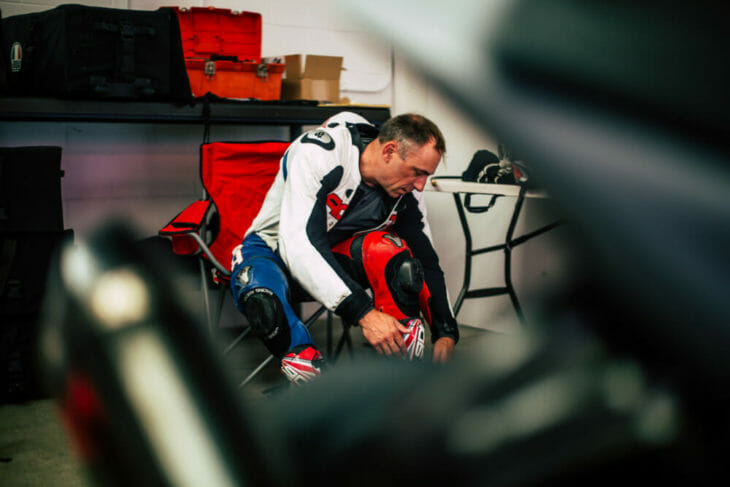 Toye was impressed by the high-speed stability of the Aprilia, but we need to get the really slow speed maneuvering right before heading to Pikes Peak.
Toye was impressed by the high-speed stability of the Aprilia, but we need to get the really slow speed maneuvering right before heading to Pikes Peak.
Turns out, the .95 spring was almost perfect for the Tuono. I shaved almost two seconds immediately off my time in traffic and the chassis would hold itself up better under hard acceleration while still remaining stable in the fast sweepers. We lost a touch of that important low-speed pivoting ability we were working on, but it was a minimal loss as the overall gain with the heavier spring was worth it.
I’m absolutely ecstatic to have a guy like Jeremy in my corner as his help, just on the phone and later, on track, has been invaluable.
We’ve got another few days lined up in the coming weeks and one month from today we’ll be on the mountain for the tire test for the 2019 Pikes Peak International Hill Climb. It’s getting serious now!
Pikes Peak 2019: Project Thunder COTA Test
The last couple of weeks have been an enormous blur, a mix of airplanes, test bikes, more planes, MotoGP and, you guessed it, more planes. But that hasn’t stopped Project Thunder for Pikes Peak 2019, and thanks to the help of Mark Cocoran and Brad Friedman from Piaggio Group Americas, we managed to get the Aprilia Tuono into a ride-able state and spin some laps at Circuit of The Americas a day after the MotoGP round for the Aprilia Racers Days track day.
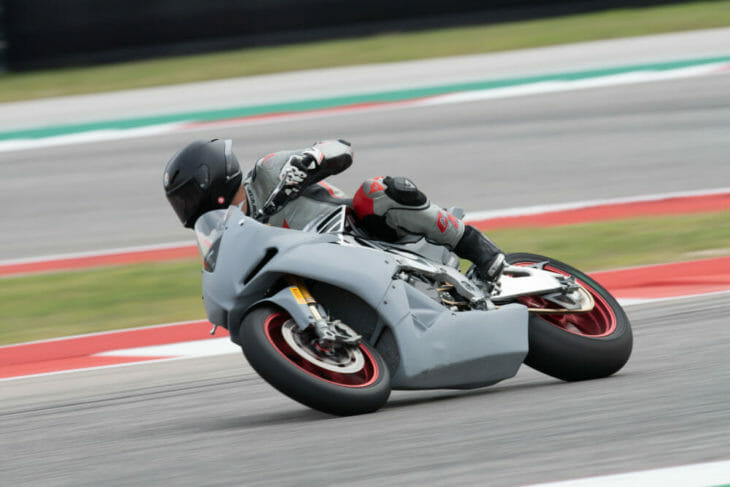 It’s starting to look more like a racebike, but there’s still much to do with the Aprilia.
It’s starting to look more like a racebike, but there’s still much to do with the Aprilia.
Jeremy Toye and I ripped into the Aprilia Tuono racer a few weeks back, but by the time it left to go to Texas, there was still a lot (a lot) of work to be done. We got the shock and exhaust fitted and removed all the road-going bodywork, but Mark and Brad still had to put a solid day into it to have it ready for CoTA.
The most obvious change was the looks. We managed to fashion up some RSV4 bodywork, with Mark and Brad doing an excellent job in mounting the dash and tidying up all the wiring that was left over after the lights came off. At first, I had to do a double take as the Tuono looks like a full-on RSV4, but once you see the straight bar you know it’s a nakedbike in drag.
Another new part of was the RSV4 Factory 1100 forks. These are stiffer and 5mm longer than the ones that come stock on the RSV4, which, when combined with the shock that’s 9mm longer, will give us a nice boost in ground clearance for the mountain.
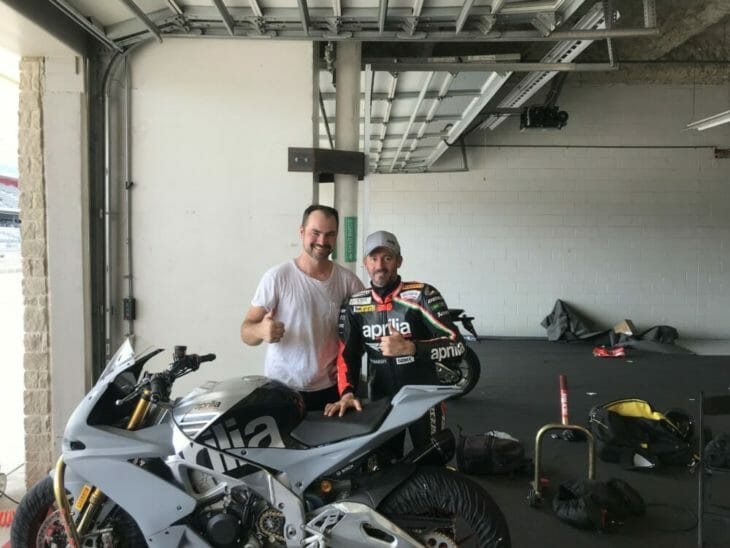 We had a very famous guy sitting next to us in the pits… Aprilia ambassador (and six-time World Champion) Max Biaggi!
We had a very famous guy sitting next to us in the pits… Aprilia ambassador (and six-time World Champion) Max Biaggi!
The test at CoTA went great—we managed to get a solid 40 laps on the Tuesday, playing around with different suspension settings to see what works. We need to get a heavier shock spring as the .85Nm unit is too soft for my massive ass, although I’m not sure how much heavier we’ll need to go as setting the bike up for Pikes and CoTA are two very different things.
The bike is now back with Jeremy, who is creating a map for it in with the Power Commander, and getting the new brake master-cylinders and rearsets fitted. Our next test will be at The Ridge on May 6 at The Ridge in Washington.
Pikes Peak 2019: Project Thunder Gets Underway
After three seasons of racing the KTM 1290 Super Duke, for 2019, Team Cycle News and I will be riding with Aprilia and the stupendous Tuono 1100 Factory. This Italian V4 missile doesn’t have much history at America’s Mountain in Colorado Springs, having only competed there for a couple of years with some privateers without a reasonable shot at winning the race.
Pikes is one of those races that gets under your skin. It’s an iconic world motorsport event, one that doesn’t get the recognition it deserves and is something I really want to tick off the list for Cycle News and my country.
The Pikes Peak International Hill Climb has become somewhat of a staple in the Cycle News office for the past four years. It’s been a race I’ve come so close to winning, finishing fourth in 2016 and then second in 2017 and 2018, that race being the closest ever finish in the history of the race with 0.67-second separating me and winner Carlin Dunne.
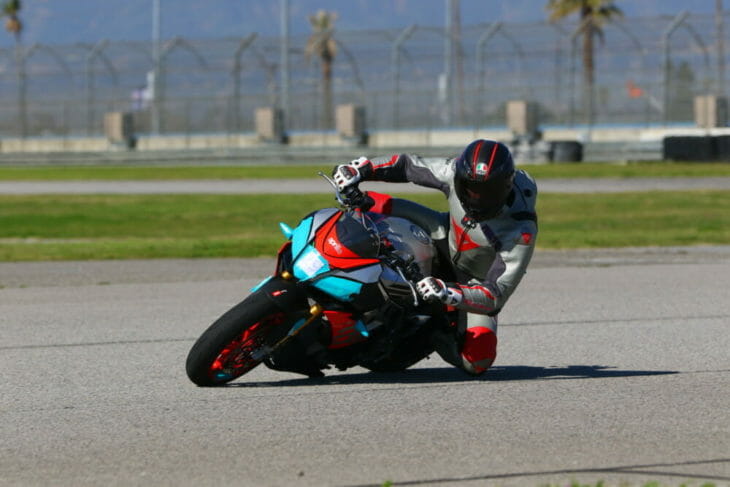 In standard form, the Tuono is a weapon of a bike, but it isn’t a real racer.
In standard form, the Tuono is a weapon of a bike, but it isn’t a real racer.
This is something we hope to change. We’ve teamed up with Piaggio Americas, we’ve got a great base in the Tuono, and we have former race winner Jeremy Toye doing the majority of the wrenching for the race with some build help from AF1 Aprilia in Austin, Texas. Tuono translates to Thunder in Italian, so hopefully that’s a good omen for us as we blast up the mountain!
Building Project Thunder
Starting off with the base package Tuono 1100, we already have a claimed 175 hp from the 65° V4 motor. It’s a stunningly fast machine as standard and comes with some of the best suspension, brakes, and electronics on the market today.
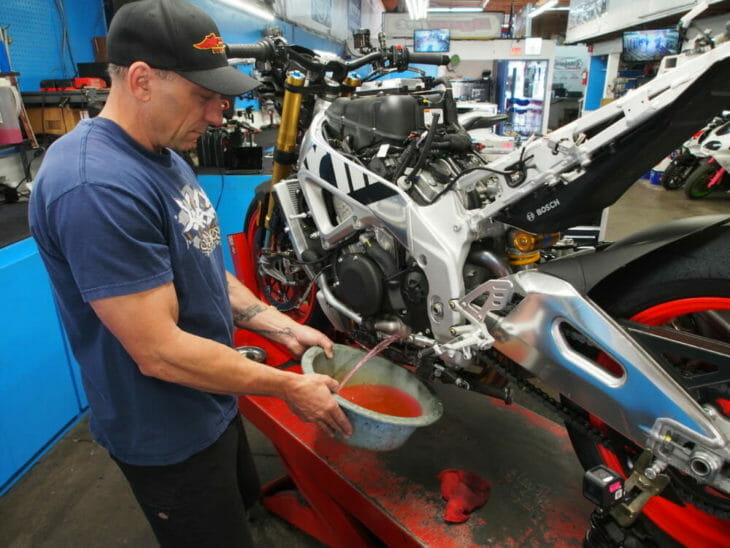 Jeremy Toye has won the race in 2015, so he knows what it takes to build a good racebike for the mountain.
Jeremy Toye has won the race in 2015, so he knows what it takes to build a good racebike for the mountain.
The idea for our racebike build is not to go too nuts on the build, but just to enhance what’s already there. I feel like in the past with my racebikes for the Mountain I’ve gone too stiff on the set up, which has hampered me a bit in the mid-section of the track. Don’t get me wrong, the KTM is as dear to my heart as any motorcycle I’ve ever ridden and holds the lap record with Chris Fillmore, however, for the Aprilia, we’re going to try something new.
The main thing is to strip off as much weight as we can. Just the stock bodywork, associated plastics, battery, exhaust, shock and bits and bobs will save us a ton of weight. To that end, the build will feature an Ohlins TTX36 shock, full titanium Akrapovic exhaust, Attack Racing rearsets, 520 D.I.D chain and AFAM sprocket kit, and a lightweight lithium-ion battery.
Being a nakedbike, we’re not going to fully cloak the bike in bodywork, but we’ll be using an RSV4 upper cowling and side panels, and an RSV4 race seat unit. Most of this stuff bolts on without too much modification, anyway, although we’ll have to get some mounting brackets made up for the bodywork.
Setting Up For Pikes Peak
One of the big things with Pikes is ensuring the bike doesn’t ground out when going over the bumps and G-outs. This was something the KTM never had an issue with as it’s taller than the Aprilia straight out of the box, but it’s something we need to check on the Aprilia.
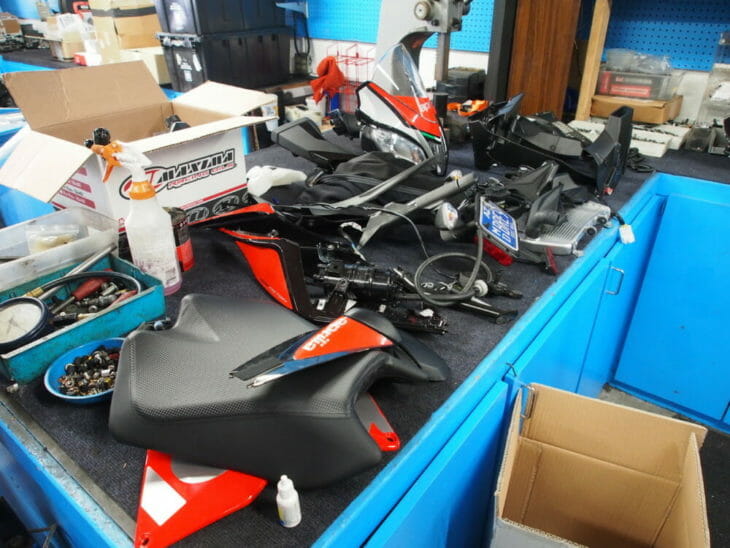 For a naked bike, there’s a surprising amount of bodywork we need to get rid of.
For a naked bike, there’s a surprising amount of bodywork we need to get rid of.
Because of this, we’ll be running Aprilia RSV4 1100 Factory forks. The forks are 5mm longer than what’s found on the Tuono 1100 Factory, and the TTX36 shock is also 8mm longer than standard. That will give us a healthy gain of ground clearance, so hopefully that’s all we’ll need because the base bike steers so well I don’t want to mess with the geometry too much.
Another thing I can’t wait to try is the Brembo thumb brake. We’ve yet to get all the components sorted, but the plan is to run and thumb and foot rear brake in the race. I’ve never run one before, but I’m not a massive user of the rear brake and those riders I’ve spoken to with a similar style to mine all swear by the thumb brake so, what the heck, it’s as good a time to try one as any! I probably won’t have this sorted until May but will report back with how it performs.
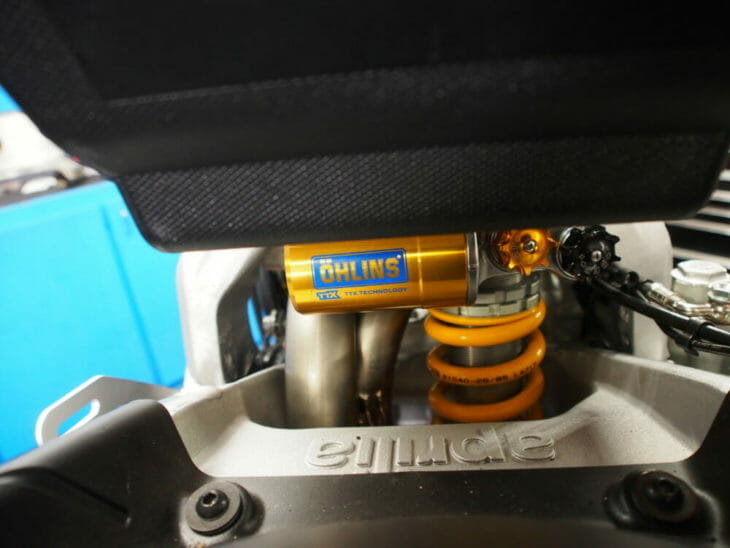 The Ohlins TTX shock is used universally on race and track bikes, and after a few years on WP, it’ll be nice to see the differences at the mountain.
The Ohlins TTX shock is used universally on race and track bikes, and after a few years on WP, it’ll be nice to see the differences at the mountain.
On the rubber side, we’ll be of course using Pirelli. The Italian rubber brand has been on my wheels since my race debut in 2016, and have been an integral partner in each one of my race attempts.
Hanging With Jeremy Toye
We spent a day two weeks ago with Jeremy in his shop, getting the titanium Akrapovic exhaust and the Ohlins TTX36 shock fitted. This is a seriously tightly packaged motorcycle, so getting especially the exhaust mounted correctly was a bit of a challenge.
From there, we packed the very unfinished bike and headed for Austin, where we’ll do a two-day test following the MotoGP race. The bike is currently on its way to AF1 to have the rearsets and bodywork fitted, and we’ll fit the forks at the track and play around with various settings until we find one that works. We might have to go up in spring rates for the fork, but I’ll wait to see how it performs in Tuono form first (I rode the fork on the new RSV4 1100 at Mugello and it’s an absolute gem).
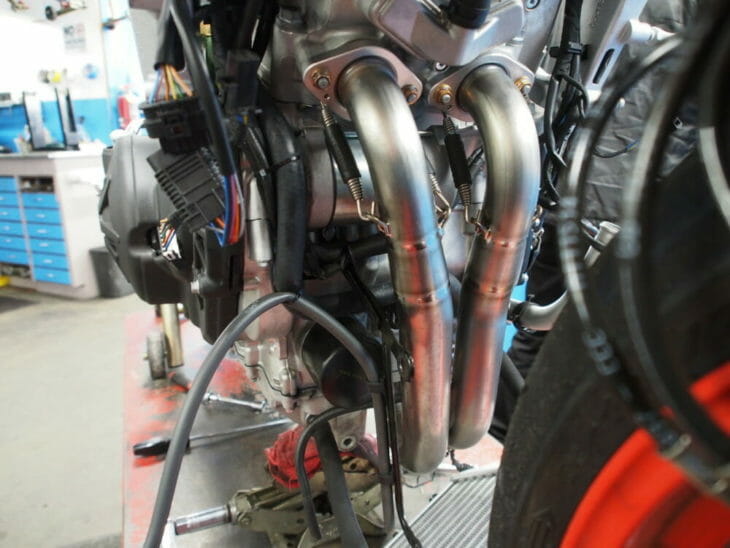 This Akrapovic exhaust is so light it’s hard to believe it actually works. And it’s absolutely beautiful, too.
This Akrapovic exhaust is so light it’s hard to believe it actually works. And it’s absolutely beautiful, too.
It’s going to be a busy couple of months, but we’re super excited to team up with Aprilia for a crack at the Heavyweight title. There’s a lot of work to do, but the project will be a fun one to document and eventually turn into a proper racer.
This project would not be possible without a long list of sponsors who have generously help us out. We’d like acknowledge Aprilia USA, Akrapovic, Brembo USA and Race Technologies, Ohlins USA, Pirelli Moto USA, Dainese, AF1 Aprilia in Austin, TX, and Imad and the crew at Fastrack Riders for the Fontana track time.